From the time it became available to the general public, Generative AI (GenAI) began to transform the way brands approach content creation and management. With the ability to generate text, images, video, audio, music, and even entire marketing campaigns and strategies, it’s created space for creatives (and many others) to do so much more with less.
GenAI presents an unprecedented opportunity to boost productivity across every aspect of the content supply chain and get content in front of audiences at record speed, an advantage in today’s competitive digital landscape.
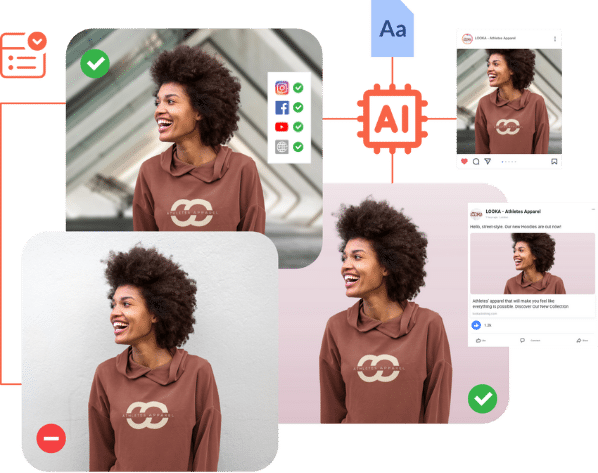
However, alongside the excitement, there’s a sense of caution looming. As legal complexities and brand compliance challenges around GenAI content creation become more apparent, executive teams must grapple with how to adopt this powerful technology without exposing their brands to very large risks.
This blog explores how brands can strategically adopt GenAI for content creation to boost productivity while navigating challenges around compliance, brand consistency, and responsible use.
We’ll unpack key insights and strategies from our webinar with Bria.AI and offer a roadmap for successfully leveraging GenAI–without the risks.
Why Embrace GenAI? It’s the Next Chapter in the Data Revolution.
First off, why do brands have to grapple with how to adopt GenAI in the content supply chain?
From the dawn of writing to the invention of the printing press and the rise of the Internet, each milestone has fundamentally changed how we create, share, and consume information.
GenAI is the next chapter in this data revolution that has shaped our society, as a powerful tool that uses massive amounts of data to generate content and ideas at a speed previously unimaginable.
Like most revolutionary technologies, GenAI has been met with skepticism—especially because we’re in the “Napster Era,” where copyright laws and intellectual property regulations are still catching up.
But, remember, there were many doubts about the Internet when it first became accessible History has shown us that such revolutionary technologies eventually become integral to our lives, and GenAI is on a similar trajectory.
With its undeniable involvement in our lives, marketing, creative, and executive teams need to understand GenAI’s immense potential and how to use it while upholding compliance and, of course, maintaining the authenticity of their brand.
Use Cases for Generative AI
Basic Content Creation
One of GenAI’s most popular applications today is content creation, whether it be text, images, video, or audio.
We’ve all tried text generation out by now (if you haven’t, that’s step 1). For instance, you might prompt ChatGPT with “Create a product description for a new eco-friendly water bottle,” and it generates a detailed description that highlights the product’s features, benefits, and environmental impact.
GenAI can generate images in the same way, based on textual descriptions or specific design prompts. For example, you might input “create an image of a light blue, slim, eco-friendly water bottle,” and the AI will produce an image that matches this description.
With the ability to generate a variety of content mediums in seconds, GenAI has massive potential for marketers and creatives. Leveraging a prompt like the example above, you can essentially create a rough first draft in your ideation stage–we say first draft because the output using open AI likely won’t be perfect–more on that below.
Even so, this “basic” use case can still help you reduce time spent ideating, writing, designing, and researching. This accelerates the creative process and expands the range of content possibilities, introducing new ideas and making it easier to experiment with them.
On-Brand Content Creation
Building on the content creation use case, you can use GenAI to develop content that adheres to your specific brand guidelines.
Open-source models, like ChatGPT, are trained on broad datasets across topics and industries, making their output less specific to any single brand’s unique tone or aesthetic.
But imagine you have a dataset of your brand’s previous visual assets and messaging styles. By training a generative model on this dataset, you can produce new content that maintains the same tone, aesthetic, and style as your existing visuals and messaging.
Here’s an example from a game developer who trained a GenAI model on a dataset of their game’s art style:
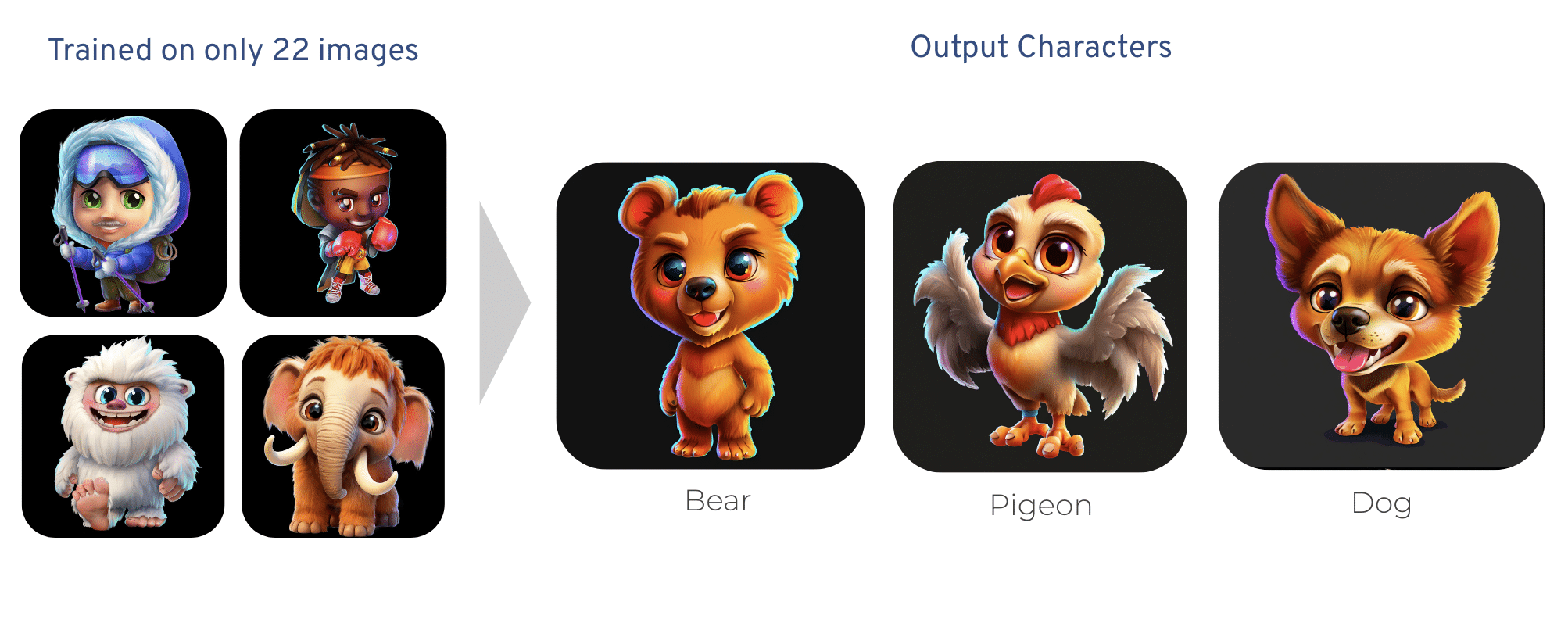
With a model they trained, they generated new characters that aligned with the look and feel of their existing characters.
Training a model on your own data allows you to leverage GenAI to create content that is consistent with your brand, as opposed to the more generalized output that you’d get using open-source models. This means you could take it out of the draft stage while still maintaining brand compliance.
Catalog Enrichment & Product Placement
An especially significant use case for eCommerce businesses, GenAI can help you enrich product catalogs. Let’s return to the water bottle example – with GenAI, you can take a single image of this product and generate multiple variations in different scenes.
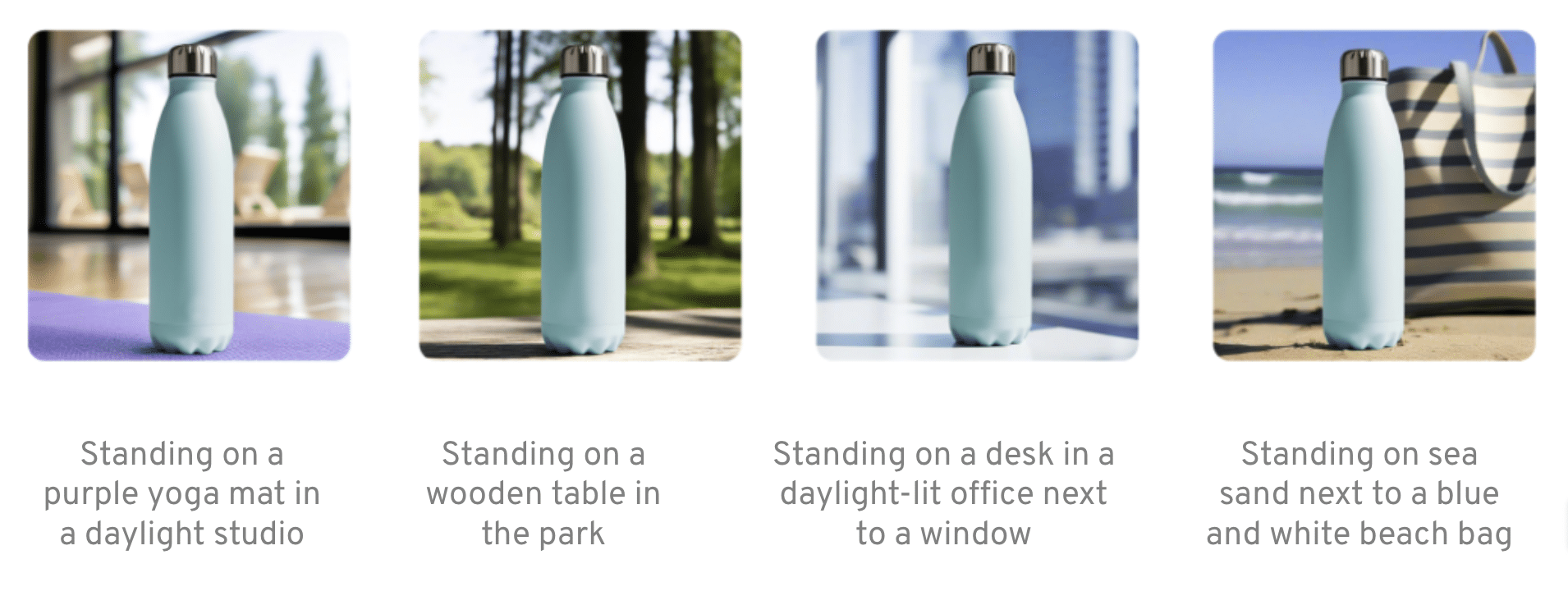
Pro Tip: For the best results, Bria.AI recommends using an actual product image and generating various backgrounds or scenes rather than trying to generate both the product and the scene.
This use case is beneficial for targeting different geographies or demographics with the same product. For instance, you could create variations of the product showcased in various geographic regions, similar to the example above. You could also generate versions to target by gender, age, lifestyle, or cultural nuances.
Building on this enrichment, GenAI also allows you to create variations of a product, which are shown from multiple angles in different sizes and locations in the image. This approach allows you to present the product in the best light again, for a particular audience and also for a specific advertising platform, without the need for an actual photoshoot.
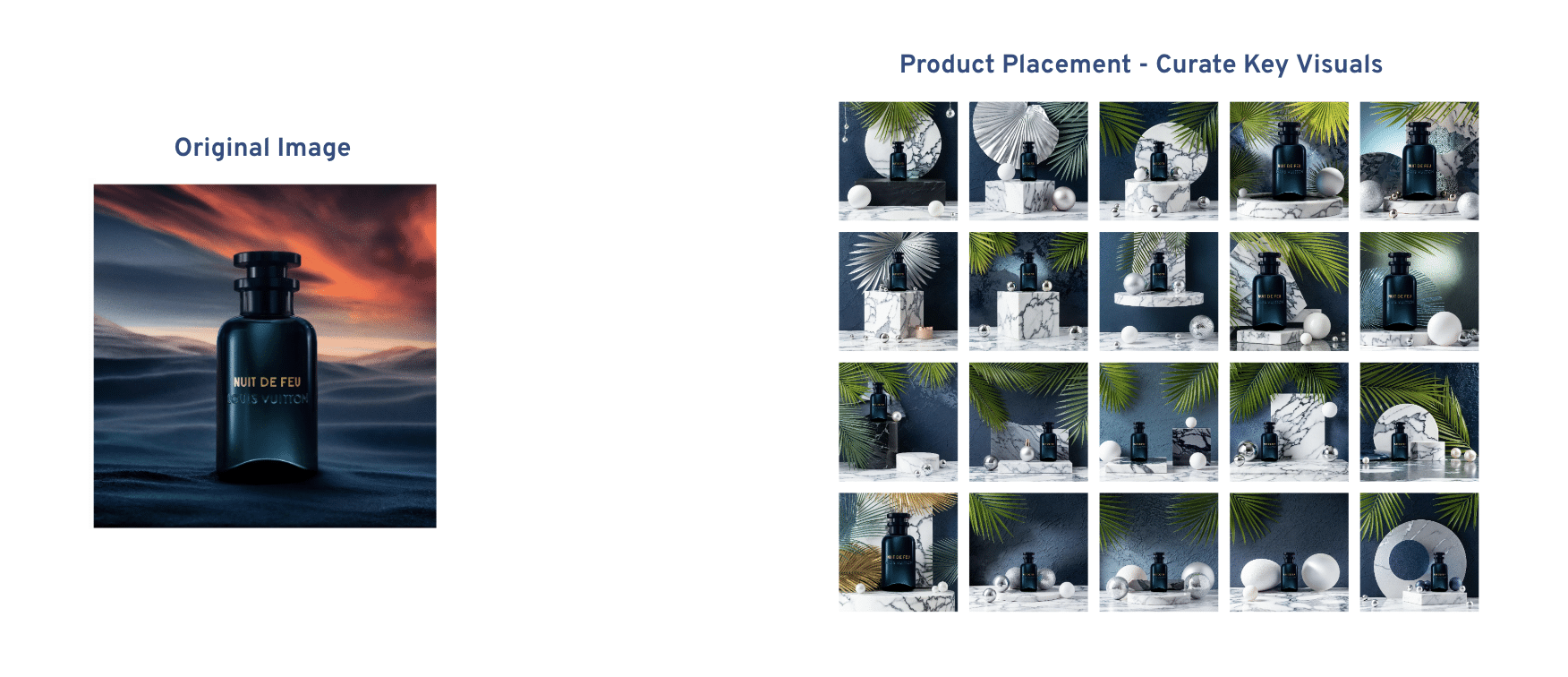
Leveraging GenAI for catalog enrichment and product placement empowers creatives and marketers to generate near-infinite variations without spending a ton of time on manual design work. This enables highly personalized content creation for effective audience targeting and supports rapid A/B testing to see which versions perform best.
Generative Fill
Have specific images that you want to reuse but would like to change them up or edit a few details? GenAI is also great for adding or changing elements within an image without spending hours using design or editing tools.
Here’s a pretty simple example where adding a flower makes the image more interesting.
This flexibility in content reuse helps extend the life of your visuals while keeping them relevant to evolving campaigns.

Marketing Materials at Scale
A final key use case—which always excites marketers—is the ability to leverage GenAI to generate marketing materials at scale. By uploading your product images, you can create multiple iterations for different social and advertising platforms–or even entire campaigns–in seconds.
For example, you could generate various versions of a product ad tailored to Instagram, Facebook, and email campaigns, each with slightly different visuals and text as prompted, to maximize engagement on that specific platform.
Additionally, when integrated with your Digital Asset Management (DAM) and Product Information Management (PIM) systems, you can incorporate product data to create localized versions of marketing materials more efficiently. This saves time, reduces manual effort, and helps to ensure consistency across global campaigns.
Watch a marketing campaign get created in seconds:
GenAI’s Potential in the Content Supply Chain
Let’s be honest—teams aren’t going to change the way they work overnight. So to unlock GenAI’s potential, the technology you use needs to work with and across your current MarTech stack and processes.

Digital Asset Management (DAM) systems play a crucial role in creating this synergy as the centralized platform that brands use to organize, share, distribute, and publish digital assets and as the only technology that touches every aspect of the content supply chain.
Integrating DAM with GenAI gives the tool access to your approved digital assets (or a collection that you select). DAM can also help pull information from PIM, DRM, and other connected systems into the solution, as mentioned in the marketing materials use case
Managing the Risks Associated with Generative AI & Content Creation
We’ve talked about it before, and we’ll do it again–as powerful as these GenAI use cases are, adoption of this technology needs to come with a nuanced understanding of the legal, ethical, and brand risks.
Understanding and mitigating these risks will ensure that GenAI elevates rather than undermines your content strategy. So, let’s get into them.
Legal and Regulatory Risks
One of the most pressing concerns around GenAI (and one you’ve likely seen in the news) is the potential for legal and regulatory issues.
As we mentioned, open-source models are trained on massive, publicly available datasets, and as a result, the output may include unlicensed and/or copyrighted material. Further complicating this is that you often cannot control what data was used to create the output or verify where the elements used came from.
If AI-generated content you publish unintentionally replicates elements from protected works, your brand could face trademark violations or lawsuits over unlicensed usage.
The Solution: Use What You Already Own
As we alluded to throughout the use cases, you can train generative models on your proprietary assets and datasets (Hint: this is a common thread through the solutions to manage risk!). Using your own content to train a model eliminates any ambiguity around where the output came from, ensuring that it’s created from material you already own and have the rights to use. This frees you from potential copyright infringement.
Quality Control
Quality control is another challenge, especially when models are trained on publicly available and uncurated data sets. When GenAI generates content from broad datasets that aren’t tailored to your brand, the output can vary widely in quality and relevance.
A picture is worth a thousand words to expand on this point…

While the output can be pretty funny, it can also be pretty useless and lends itself to the risk of wasting time and resources.
The Solution: Implementing Quality Assurance Processes
Here’s the common thread–training a generative model with your own data will ensure that the output better reflects your brand’s voice and typical quality.
However, to mitigate quality risks, brands should establish robust quality assurance processes for all AI-generated content intended for publication. This may include setting clear criteria for evaluating the output, such as clarity, coherence, and relevance to the target audience, as well as developing workflows for approving the content based on these criteria.
Human reviewers assessing the AI-generated content can (and should) also provide feedback to the model, which helps improve the model’s output quality over time.
Brand Compliance
When GenAI creates content that doesn’t reflect your brand’s unique style, tone, or values, you risk diluting your brand image and creating inconsistencies—even if you’re using AI-generated content solely for ideation. Additionally, open-source models may not align with your DEI (Diversity, Equity, and Inclusion) standards, inadvertently generating content that lacks inclusivity or diverse representation.
Again, output that isn’t consistent with your brand can make you laugh but also waste your time.
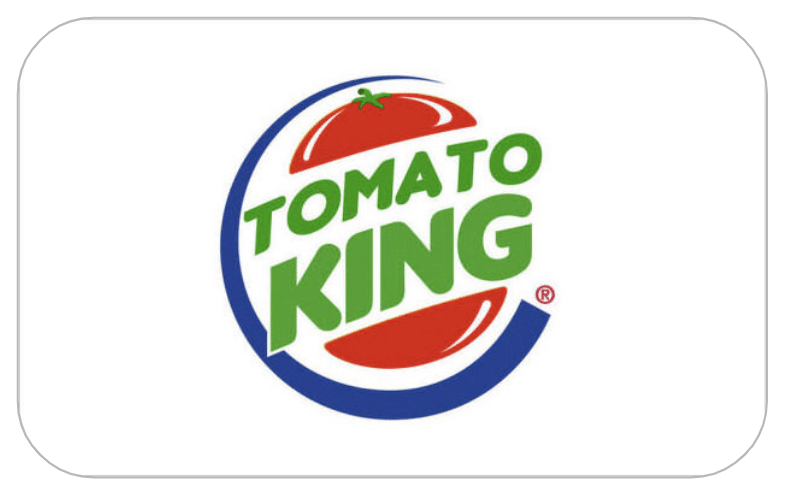
The Solution: Train on Your Brand Guidelines
The way to get the most value and consistent, low-risk results using GenAI will be pretty clear to you by now–train the model with your own data. Here, that means specifically with regard to your brand’s style, tone, and audience needs.
By using brand-specific visuals, language guidelines, and existing marketing materials, you provide the AI with the context to generate content that consistently reflects your brand identity.
Pro Tip: If your GenAI solution is integrated with your DAM, it can seamlessly access your entire library or a collection of your approved assets—like images, videos, and brand guidelines. With Tenovos Connect, integrating your AI tools into the DAM is effortless. Learn more.
Additionally, human oversight is crucial for ensuring brand compliance, as nuanced decisions about brand voice and DEI require a human perspective. At the end of the day, involving humans in the use of GenAI is how brands can achieve a balance that safeguards quality and compliance while maximizing productivity.
Key Considerations for Adopting GenAI Solutions
Let’s revisit the common thread–training a generative model with your own data is essential for both mitigating risk and maximizing effectiveness. While numerous GenAI solutions are available to achieve this, it’s important to consider these four factors when evaluating solutions as a business:
1 – Choose a Responsible GenAI Solution: Ensure that the technology you select is responsible, legal, ethical, and appropriate for commercial use, with clear guidelines for compliance.
2 – Tailoring GenAI to Your Workflow: Select a solution that can be customized to fit your specific needs and work with your existing processes to maximize user adoption and workflow efficiency.
3 – Opting for an Open Platform: Unlike an open model, which uses generalized data, an open platform allows for seamless integration with your existing systems. This enhances flexibility and scalability, ensuring GenAI fits within your content supply chain.
4 – Data Security Considerations: Inquire about how providers handle data security, including measures to protect sensitive information, data storage practices, and protocols for data breaches to ensure that your proprietary content remains secure.
Embracing and Adopting GenAI with Confidence
If you’ve made it this far, you’ve gained a deeper understanding—and hopefully some excitement—about GenAI’s content creation use cases and how to manage the associated risks.
Humans aren’t going anywhere in the creative process (we know that gets whispered about, but just check out the quality control graphics for proof!). But, by strategically adopting a moldable and responsible GenAI solution, brands can strike the right balance between creativity and compliance, making the most of the productivity gains GenAI use cases have to offer.
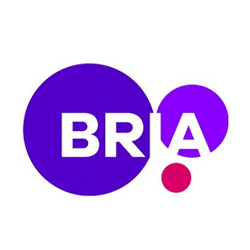
Thanks to the experts at Bria.AI for their support in developing this content!
Bria.AI specializes in responsible generative artificial intelligence (AI), offering advanced models exclusively trained on licensed data. It provides a holistic GeneAI solution for commercial use, promoting a sustainable and fair creative ecosystem through ethical practices.
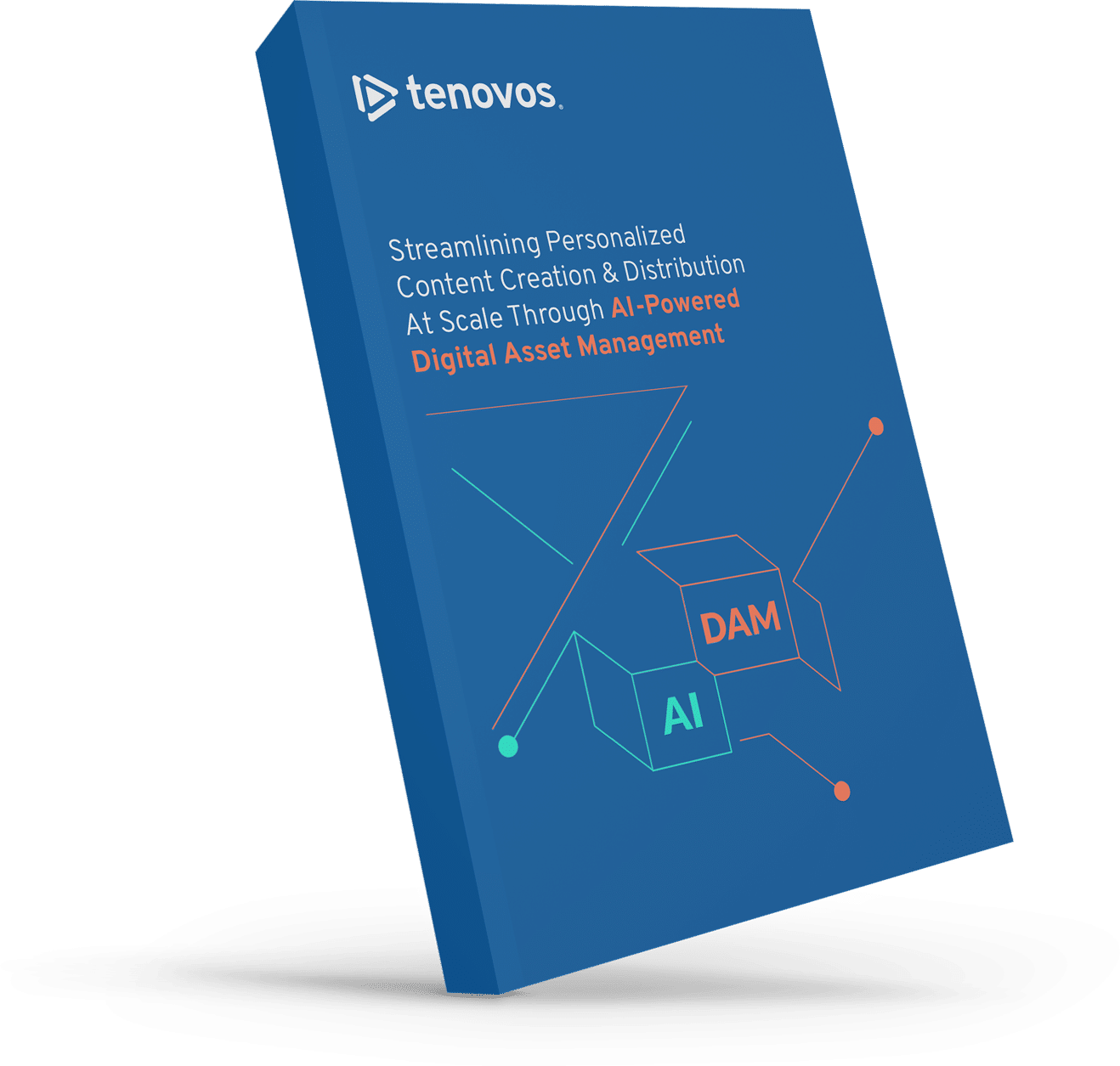
Craving More AI Insights?
Discover the AI features in Digital Asset Management that support even more efficiency and personalization.
